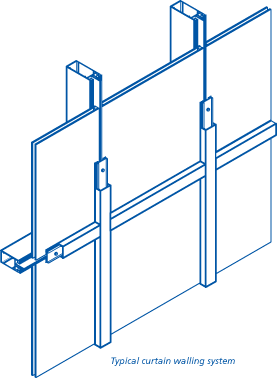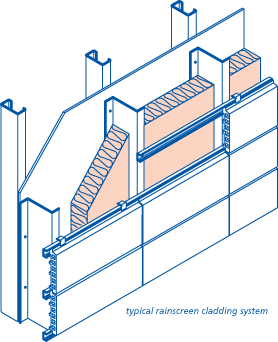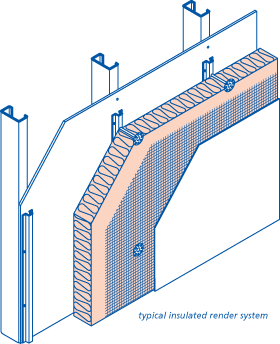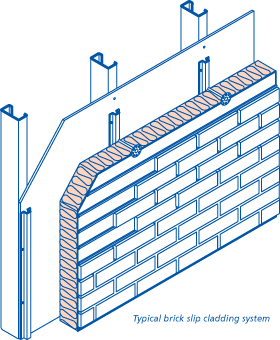6.9 Curtain walling and cladding
SCOPE
INTRODUCTION
| Introduction |
| Curtain walling |
| Rainscreen cladding |
| Insulated render |
| Brick slip cladding |
| Stone & precast concrete cladding |
| Definitions (for this chapter) |
DESIGN STANDARDS
| Design | |
| 6.9 - D1 | Design standards |
| 6.9 - D2 | Statutory requirements |
| 6.9 - D3 | Design life |
| 6.9 - D4 | Accessibility for maintenance |
| Curtain walling | |
| 6.9 - D5 | Certification |
| 6.9 - D6 | In-service performance |
| Rainscreen cladding | |
| 6.9 - D7 | Certification |
| 6.9 - D8 | In-service performance |
| Insulated render systems | |
| 6.9 - D9 | Certification |
| 6.9 - D10 | In-service performance |
| Brick slip cladding systems | |
| 6.9 - D11 | Certification |
| 6.9 - D12 | In-service performance |
| General | |
| 6.9 - D13-D14 | Provision of information |
DESIGN STANDARDS
Design that follows the guidance below will be acceptable for curtain walling and cladding.
STATUTORY REQUIREMENTS
Design should be in accordance with relevant Building Regulations and other statutory requirements.
DESIGN LIFE
Items to be taken into account include:
(a) primary components
Primary components should be designed and specified to provide satisfactory in-service performance for the design life of the building. See Technical Requirement R3.
(b) secondary components
Secondary components should be designed and specified to provide satisfactory in-service performance for at least 25 years.
ACCESSIBILITY FOR MAINTENANCE
Provision should be made for safe future access to the façade. Access should normally be provided from a safe working platform such as a cradle or mobile elevating platform.
Appropriate arrangements should be made for the replacement of failed insulating glass units without incurring excessive costs for gaining access.
Curtain walling
CERTIFICATION
Curtain walling systems should have certification confirming satisfactory assessment in accordance with the current CWCT Standard for Systemised Building Envelopes by an appropriate independent technical approvals authority accepted by NHBC. The CWCT Standard provides detailed guidance on performance and testing.
Other certification bodies or test documentation may be acceptable if they are considered by NHBC to be a suitable alternative.
The certification, together with all test documentation should be made available to NHBC before work on the curtain walling or cladding begins on site.
The use of the system should be within the scope of the certification and test documentation.
IN-SERVICE PERFORMANCE
Items to be taken into account include:
Dead and live loads should be transferred safely to the building's structure without undue permanent deformation or deflection of any component.
Imposed loads should be calculated in accordance with BS 6399 and take account of both internal and external pressures, together with the location, shape and size of the building.
Thermal-induced loads due to differential stresses caused by temperature gradients within materials or components should be accommodated without any reduction in performance. The stresses in components and materials should not exceed the permissible values recommended by the product manufacturer.
Movement within the curtain walling should be accommodated without any reduction in performance. Causes of movement include:
- dead and live loads
- changes in temperature
- changes in the moisture content of components
- freezing of retained moisture
- creep.
Fixings and supports should be designed to accommodate specified loads and take account of the product manufacturer's recommendations.
Pull-out or destructive testing of anchors and fixings should be carried out in accordance with the design, BS 5080 and the Construction Fixings Association Guidance Note 'Procedure for Site Testing Construction Fixings'. Tests should be carried out at a suitable rate agreed with NHBC. The test results should be made available to NHBC.
Packing of brackets to achieve surface tolerance should be permitted only in accordance with the product manufacturer's recommendations.
Insulating glass units should be in accordance with Chapter 6.7 'Doors, windows and glazing'.
The curtain walling system, including doors, windows and other openings, should resist the passage of water to the inside of the building, allow free drainage and not trap water. It should have:
- external and internal air and water seals, and
- drained and ventilated glazing rebates.
Particular attention should be given to the interfaces between the curtain walling system and other elements or cladding systems.
External and internal air and water seals and a drained ventilated cavity should be provided at all interfaces. Guidance on interfaces is provided in Appendix 6.9-A.
Appropriate gaskets and sealants should be used to resist the flow of air from the outside to the interior surface of the curtain walling system. Particular attention should be given to the interfaces between the curtain walling system and the walls, roof, doors, windows and cladding system.
Pre-formed factory-moulded 'picture frame' type vulcanised epdm or silicone internal gaskets should be used for all curtain walling systems.
Sealant should be specified in accordance with BS 6213 and the manufacturer's recommendations.
The curtain walling system should be designed to minimise the risk of surface and interstitial condensation by the use of thermal breaks and a continuous vapour control layer.
Thermal bridging should be controlled to ensure no part of the curtain wall is more at risk of surface condensation forming than the glazing.
Noise from the curtain walling system caused by loads, movements and changes in the environmental conditions should be accommodated without being intrusive.
The curtain walling system should be designed to resist the passage of airborne and impact sound within the building. Particular attention should be given to flanking transmission at:
- the edges of separating floors
- the outer ends of separating walls
- the outer ends of partition walls
- the junctions with roof constructions and parapets.
Air and water testing of the 'prototype' curtain walling system should be carried out in accordance with and pass the CWCT Standard (test sequence A or B) tested at a test pressure of 600 Pascals. Panels tested should be of similar size and configuration to those to be used on the building.
Where the maximum calculated design wind pressure is above 2400 Pascals the test pressure should be increased to 0.25 x the design wind pressure.
The 'prototype' should remain watertight during and after the test.
At a test pressure of 600 Pascals an air infiltration rate no higher than 1.5m3/hr/m2 for fixed glazed panels is permissible provided there is no evidence of concentrated leakage.
Wind resistance, serviceability and safety testing should be carried out in accordance with the CWCT Standard.
The curtain walling system should comply with BS 7671 'Requirements for Electrical Installations, formerly IEE Wiring Regulations' and BS 6651 'Code of Practice for Protection of Structures against Lightning'.
The curtain walling system should be constructed with corrosion resistant or adequately protected materials. The risk of bimetallic corrosion should be avoided by the isolation of dissimilar metals.
Aluminium components should be separated from direct contact with cementitious surfaces.
The curtain walling system should not include materials liable to infestation attack by micro-organisms, fungi, insects or vermin.
Where timber is used it should be treated in accordance with the guidance in Chapter 2.3 'Timber preservation (natural solid timber)'. Timber should only be used where it can be easily inspected and replaced without disturbing the curtain walling system.
The design should allow for the line, level, plumb and plane of the completed curtain wall to be within reasonable tolerances. See Chapter 1.2 'A consistent approach to finishes'.
Rainscreen cladding
CERTIFICATION
Rainscreen cladding systems, including panels, should have current certification confirming satisfactory assessment by an appropriate independent technical approvals authority accepted by NHBC, including: British Board of Agrément (BBA) or Building Research Establishment (BRE) Certification.
Systems that are assessed and certificated by an appropriate independent technical approvals organisation in accordance with the CWCT Standard for Systemised Building Envelopes will normally be acceptable to NHBC.
Other certification bodies or test documentation, may be acceptable if they are considered by NHBC to be a suitable alternative.
The certification, together with all test documentation should be made available to NHBC before work on the rainscreen begins on site.
The use of the system should be within the scope of the certification and test documentation.
IN-SERVICE PERFORMANCE
Items to be taken into account include:
Dead and live loads should be transferred safely to the building's structure without undue permanent deformation or deflection of any component.
Imposed loads should be calculated in accordance with BS 6399 and take account of the location, shape and size of the building.
Thermal-induced loads due to differential stresses caused by temperature gradients within materials or components should be accommodated without any reduction in performance. The stresses in components and materials should not exceed the permissible values recommended by the product manufacturer.
Movement within the rainscreen cladding should be accommodated without any reduction in performance. Causes of movement include:
- dead and live loads
- changes in temperature
- changes in the moisture content of components
- freezing of retained moisture
- creep.
Fixing rails, frames, fixings and fasteners should be designed to accommodate specified loads and take account of the product manufacturer's recommendations.
Pull-out or destructive testing of anchors and fixings should be carried out in accordance with the design, BS 5080 and the Construction Fixings Association Guidance Note 'Procedure for Site Testing Construction Fixings'. Tests should be carried out at a suitable rate agreed with NHBC. The test results should be made available to NHBC.
Bonded fixings should be specified only where there is no suitable alternative and should be designed in accordance with the product manufacturer's recommendations.
Packing of the supporting rails, frame or the panel fixings to achieve surface tolerance should be permitted only in accordance with the product manufacturer's recommendations.
The air gap between the face of the insulation and the back of the rainscreen panels should be of sufficient width to allow any water passing the joints to run down the back of the rainscreen panels and be discharged externally without wetting the insulation or the backing wall.
The design should avoid the need for disproportionate work when repairing or replacing individual components.
The design should ensure that water is prevented from reaching any parts of the wall that could be adversely affected by the presence of moisture.
Sealants should be specified in accordance with BS 6213 and the manufacturer's recommendations.
The minimum width for air gaps should be:
- 50mm for panels with open joints
- 38mm for panels with baffled or labyrinth (rebated) joints.
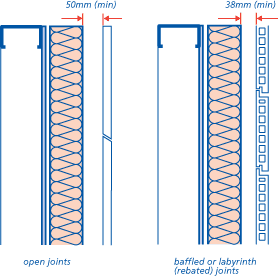
The air gap should be adequately ventilated. Dpc/dpm trays with stop ends should be provided above openings, at the base of the rainscreen and at interfaces where necessary, to ensure water is drained to the outside.
Particular attention should be given to the interface between the rainscreen cladding system and the walls, roof, doors, windows, other cladding systems, and curtain walling. External and internal air and water seals should be provided at all interfaces. Guidance on interfaces is provided in Appendix 6.9-A.
Open, baffled or labyrinth (rebated) joints should normally have a minimum opening of 10mm.
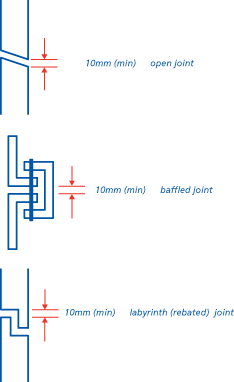
A screen to prevent birds and animals entering the cavity should be provided at the top and bottom of the rainscreen and penetrations through the cladding.
Where insulation forms part of the rainscreen cladding system it should cover all exposed areas of the backing wall, be neatly cut around fixings and brackets and be fixed in accordance with the product manufacturer's recommendations.

Where the insulation is fixed to the backing wall a minimum of one non-combustible fixing per square metre or per insulation batt, whichever is the lesser, should be provided in addition to the other fixings.
Reference should be made to BRE document BR135 - 2003 'Fire performance of external thermal insulation for walls of multi-storey buildings' when specifying the type of insulation system to be installed.
The design should ensure that the insulation is continuous around penetrations through the rainscreen cladding system.
Where the rainscreen panel joints are open and the performance of the insulation could be diminished by moisture, a breather membrane should be provided over the outer face of the insulation.
The rainscreen cladding system should be designed to minimise the risk of thermal bridging and, surface and interstitial condensation.
A vapour control layer should be provided unless a condensation risk analysis in accordance with BS 5250 shows that one is not necessary. The vapour control layer should be fixed on the warm side of the wall insulation.
The rainscreen cladding system should be fixed to a backing wall that is reasonably airtight, e.g:
- masonry walls jointed to a high standard with all joints filled
- framed walls with a rigid sheathing on the cavity face with all joints taped or sealed.
Where reasonable airtightness cannot be achieved, a separate continuous vapour permeable air barrier with joints taped or sealed should be provided on the outer face of the backing wall.
A rainscreen cladding system that has open joints between the panels should be designed as a pressure equalised system.
The cavity should be compartmented by:
- a horizontal cavity closer at each floor level, and
- vertical cavity closers at centres not exceeding 6.0m,
- vertical cavity closers at centres not exceeding 1.5m within 6.0m of an internal or external corner, and
- a vertical cavity closer as close as possible to an external corner, normally within 300mm.
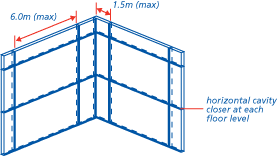
This compartmentation is in addition to the requirements of the Building Regulations for cavity barriers to control the spread of smoke and fire. However, the same cavity barriers may be used for the compartmentation.
Noise from the rainscreen cladding system caused by rain striking the outer surface of panels should be accommodated without being intrusive e.g. by the use of noise absorbing or anti-drumming material.
The rainscreen cladding system should comply with BS 7671 'Requirements for Electrical Installations, formerly IEE Wiring Regulations' and BS 6651 'Code of Practice for Protection of Structures against Lightning'.
The rainscreen cladding system should be designed with corrosion resistant, adequately protected or durable materials.
Fixings and bracketry should normally be stainless steel or a suitable non-ferrous metal.
The risk of bimetallic corrosion should be avoided by the isolation of dissimilar metals.
Aluminium components should be separated from direct contact with cementitious surfaces.
The rainscreen cladding system should not include materials liable to infestation attack by micro-organisms, fungi, insects or vermin.
The design should allow for the line, level, plumb and plane of the completed rainscreen cladding system to be within reasonable tolerances for the materials involved. See Chapter 1.2 ' A consistent approach to finishes'.
Insulated render systems
CERTIFICATION
Insulated render systems should have current certification confirming satisfactory assessment by an appropriate independent technical approvals authority accepted by NHBC, including: British Board of Agrément (BBA) or Building Research Establishment (BRE) Certification.
IN-SERVICE PERFORMANCE
Items to be taken into account include:
Dead and live loads should be transferred safely to the building's structure without undue permanent deformation or deflection of any component.
Imposed loads should be calculated in accordance with BS 6399 and take account of the location, shape and size of the building.
Thermal-induced loads due to differential stresses caused by temperature gradients within materials or components should be accommodated without any reduction in performance. The stresses in components and materials should not exceed the permissible values recommended by the manufacturer.
Movement within the insulated render system should be accommodated without any reduction in performance. Causes of movement include:
- dead and live loads
- changes in temperature
- changes in the moisture content of components
- freezing of retained moisture
- creep.
Movement joints in the backing wall should be continued through the insulated render system and formed in accordance with the manufacturer's recommendations.
Fixing rails, frames, mechanical and bonded fixings should be designed to accommodate specified loads and take account of the manufacturer's recommendations.
Pull-out or destructive testing of anchors and fixings should be carried out in accordance with the design, BS 5080 and the Construction Fixings Association Guidance Note 'Procedure for Site Testing Construction Fixings'. Tests should be carried out at a suitable rate agreed with NHBC. The test results should be made available to NHBC.
Insulated render systems, together with the backing wall to which they are applied, should satisfactorily resist the passage of moisture to the inside of the building.
For timber and steel framed backing walls a cavity of at least 15mm should be provided between the wall and the insulation to allow any moisture to drain away.
Where the backing wall is timber framed the cavity should be ventilated in accordance with Chapter 6.2 'External timber framed walls' (Design).
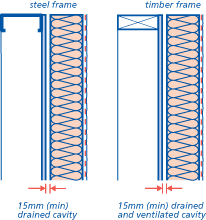
The introduction of a cavity is likely to increase the risk of impact damage to vulnerable areas of the insulated render system, e.g. at low level, around balconies and where cradle systems, etc. can come into contact with the façade. Suitable precautions to resist impact damage should be included in the design e.g. by the provision of a rigid board behind the insulation whilst maintaining the cavity.
Dpc/dpm trays with stop ends should be provided above openings, above cavity barriers, at the base of the insulated render system and at interfaces where necessary to ensure water is drained to the outside. The insulated render support system should not obstruct the drainage paths.
Insulated render systems can be applied direct to concrete panels or masonry backing walls without a cavity being provided.
Particular attention should be given to the interfaces between the insulated render system and the walls, roof, doors, windows, other cladding systems and curtain walling. Guidance on interfaces is provided in Appendix 6.9-A.
Sealants and tapes should be specified in accordance with BS 6213 and the manufacturer's recommendations.
Where appropriate, a screen to prevent birds and animals entering the cavity should be provided at the top and bottom of the cavity and to penetrations through the cladding.
The insulation type should be suitable for the intended purpose and be appropriately keyed to receive the render finish.
The insulated render system should be securely fixed to the support frame or backing wall with appropriate fixings/adhesive in accordance with the manufacturer's recommendations.
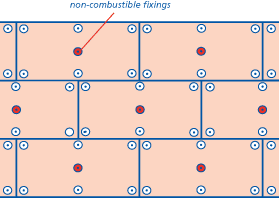
A minimum of one non-combustible fixing per square metre or per insulation batt, whichever provides the greater number, should be provided in addition to the other fixings. The non-combustible fixings should be fixed through the mesh reinforcement.
Reference should be made to BRE document BR135 - 2003 'Fire performance of external thermal insulation for walls of multi-storey buildings' when specifying the type of insulation system to be installed.
The design should ensure the continuity of insulation around openings and other penetrations.
The insulated render system should be designed to minimise the risk of thermal bridging and surface and interstitial condensation.
A condensation risk analysis in accordance with BS 5250 should be carried out. Unless it shows otherwise, a vapour control layer should be provided. The vapour control layer should be fixed on the warm side of the wall insulation.
Reinforcement mesh should be included in the design in accordance with the manufacturer's recommendations. Typically, reinforcement mesh should also be provided at points where there is a likelihood of increased stress in the render system, e.g. at the corners of window or door openings.
Appropriate trims should be provided at openings, corners, angles, interfaces and movement joints in accordance with the manufacturer's recommendations.
Proprietary render systems should be specified in accordance with the manufacturer's recommendations and include the correct number and thickness of render coats.
Corners, returns and features should be formed with appropriate trims in accordance with the manufacturer's recommendations.
The insulated render system should be designed with corrosion resistant or adequately protected materials.
Fixings and bracketry should normally be stainless steel, suitable non-ferrous metal or suitable plastics.
The risk of bimetallic corrosion should be avoided by the isolation of dissimilar metals.
The insulated render system should not include materials liable to infestation attack by micro-organisms, fungi, insects or vermin.
The design should allow for the line, level, plumb and plane of the completed insulated render system to be within reasonable tolerances for the materials involved. See Chapter 1.2 ' A consistent approach to finishes'.
Brick slip cladding systems
CERTIFICATION
Brick slip cladding systems should have current certification confirming satisfactory assessment by an appropriate technical approvals authority accepted by NHBC, including: British Board of Agrément (BBA) or Building Research Establishment (BRE) Certification.
IN-SERVICE PERFORMANCE
Items to be taken into account include:
Dead and live loads should be transferred safely to the building's structure without undue permanent deformation or deflection of any component.
Imposed loads should be calculated in accordance with BS 6399 and take account of the location, shape and size of the building.
Thermal-induced loads due to differential stresses caused by temperature gradients within materials or components should be accommodated without any reduction in performance. The stresses in components and materials should not exceed permissible values recommended by the manufacturer.
Movement within the brick slip system should be accommodated without any reduction in performance. Causes of movement include:
- dead and live loads
- changes in temperature
- changes in the moisture content of components
- freezing of retained moisture
- creep.
Movement joints in the backing wall should be continued through the brick slip cladding system and formed in accordance with the manufacturer's recommendations.
Fixing rails, frames, fixings and fasteners should be designed to accommodate specified loads and take account of the manufacturer's recommendations.
Bonded fixings of rails, frames, fixings and fasteners should be specified only where there is no suitable alternative and should be designed in accordance with the manufacturer's recommendations.
Pull-out or destructive testing of anchors and fixings should be carried out in accordance with the design, BS 5080 and the Construction Fixings Association Guidance Note 'Procedure for Site Testing Construction Fixings'. Tests should be carried out at a suitable rate agreed with NHBC. The test results should be made available to NHBC.
Brick slip cladding systems, together with the backing wall to which they are applied, should satisfactorily resist the passage of moisture.
For timber and steel framed backing walls a cavity of at least 15mm should be provided between the wall and the brick slip cladding system to allow any moisture to drain away.
Where the backing wall is timber framed the cavity should be ventilated in accordance with Chapter 6.2 'External timber framed walls' (Design).
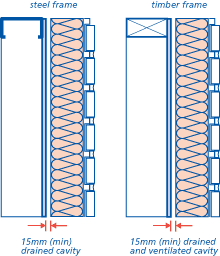
The introduction of a cavity is likely to increase the risk of impact damage to vulnerable areas of the brick slip cladding system, e.g. at low level, around balconies and where cradle systems, etc. can come into contact with the façade. Suitable precautions to resist impact damage should be included in the design e.g. by the provision of a rigid board behind the insulation whilst maintaining the cavity.
Dpc/dpm trays with stop ends should be provided above openings, above cavity barriers, at the base of the brick slip cladding system and at interfaces where necessary to ensure water is drained to the outside. The brick slip support system should not obstruct the drainage paths.
Brick slip cladding systems can be applied direct to concrete panels or masonry backing walls without a cavity being provided.
Particular attention should be given to the interfaces between the brick slip cladding system and the walls, roof, doors, windows, other cladding systems and curtain walling. Guidance on interfaces is provided in Appendix 6.9-A.
Sealants should be specified in accordance with BS 6213 and the manufacturer's recommendations.
Where appropriate a screen to prevent birds and animals entering the cavity should be provided at the top and bottom of the cavity and to penetrations through the cladding.
Insulation forming an integral part of the brick slip cladding system should be specified and fixed with appropriate fixings/adhesive in accordance with the manufacturer's recommendations.
Other insulation included in the design should be suitable for its intended purpose and be specified and fixed with appropriate fixings/adhesive in accordance with the manufacturer's recommendations.
A minimum of one non-combustible fixing per square metre or per insulation batt, whichever is the lesser, should be provided in addition to the other fixings.
Reference should be made to BRE document BR135 - 2003 'Fire performance of external thermal insulation for walls of multi-storey buildings' when specifying the type of insulation system to be installed.
The design should ensure the continuity of insulation around openings and other penetrations.
The brick slip cladding system should be designed to minimise the risk of thermal bridging and surface and interstitial condensation.
A vapour control layer should be provided unless a condensation risk analysis in accordance with BS 5250 shows that one is not necessary. The vapour control layer should be fixed on the warm side of the wall insulation.
Proprietary carriers forming an integral part of the brick slip cladding system should be fixed with appropriate fixings/adhesive in accordance with the manufacturer's recommendations.
Brick slips should be specified and fixed in accordance with the system manufacturer's recommendations.
The design should ensure that excessive cutting of brick slips is avoided, e.g. in the storey heights, at corners and around openings. Coursing should be arranged to suit lintel heights.
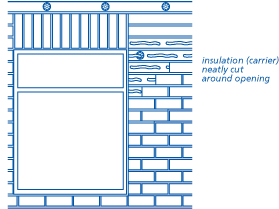
Mortars, proprietary mortars and grouts should be specified in accordance with the system manufacturer's recommendations to enable each joint to be adequately filled and appropriately struck.
Fixings for the brick slip cladding system should be corrosion resistant or adequately protected materials.
Fixings and bracketry should normally be stainless steel, suitable non-ferrous metal or appropriate plastics.
The risk of bimetallic corrosion should be avoided by the isolation of dissimilar metals.
The brick slip cladding system should not include materials liable to infestation attack by micro-organisms, fungi, insects or vermin.
The design should allow for the line, level, plumb and plane of the completed brick slip cladding system to be within reasonable tolerances for the materials involved. See Chapter 1.2 ' A consistent approach to finishes'.
General
PROVISION OF INFORMATION
Drawings and specifications should include:
- full set of drawings
- schedule of revisions
- manufacturer's specification
- fixing schedules
- specific details of all interfaces
- manufacturer's recommendations relating to proprietary items
- on-site testing regime.
Ensure that design and specification information is issued to site supervisors and relevant specialist subcontractors and/or suppliers.
Manufacturers' requirements for installation and fixing should be made available for reference on site to ensure work is carried out in accordance with the design and specification.
All relevant information in a form suitable for the use of site operatives should be available on site before work on the curtain walling or cladding starts.



















